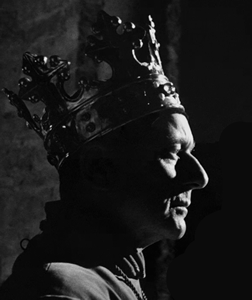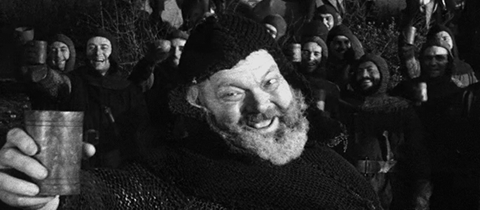I inherited a respect for Orson Welles and a love for his work from an uncle who came of age in the 1940s when Welles was one of radio and cinema’s best known actor/directors. When Chimes at Midnight came out, I was busy coming of age and rioting at UCLA. I heard about the film and that Welles considered it his best work, but I missed it. Then, like the mysterious Mr. Welles himself, it disappeared for decades. Now, it’s back.

But, what is Chimes at Midnight? Where did it come from and where did it go?
When Welles himself was coming of age, at the Todd Seminary for Boys in Woodstock, Illinois, his passion for the theater and Shakespeare in particular planted the seeds of Chimes at Midnight.
Welles combined and condensed eight Shakespearean histories into one play centered on the character of Sir John Falstaff.
Welles played him at that time, several more times in various productions over the years, and finally in his own film version of production of Chimes at Midnight, which he shot between September 1964 and April 1965.
Premiering at the Cannes Film Festival in 1966, Chimes at Midnight received scant screenings in the United States because of a bad review in the New York Times. As the world entered the home video era in the 1980s, rights disputes kept it from ever having a VHS or DVD release.

Luckily for me, and you, Janus Films has rescued and restored it, and it opens at Cinefamily in Los Angeles and Film Forum in New York on January 1, 2016.
Chimes at Midnight tells the story of Falstaff, whom Welles considered the ultimate father figure. For those of you whose mothers didn’t read you Shakespeare as bedtime stories, as Welles’ mother did, I’ll provide some background.
Shakespeare wrote a series of historical plays about English kings. Falstaff is a recurring character in these plays and provides a stand-in father for Prince Hal. The prince is torn between his real father, Henry IV, and Falstaff. Portrayed in most productions as a buffoon, for comic relief, Falstaff was taken by Welles and made the focus of the story. The screenplay for Chimes at Midnight incorporates parts of Shakespeare’s Henry IV Part I, Henry IV Part II, Henry V, Richard II, and The Merry Wives of Windsor.
That shouldn’t work, should it? But don’t forget, this is Orson Welles we’re talking about. Besides Welles, the film is blessed by the presence of Jeanne Moreau (Jules and Jim, La Notte, Diary of a Chambermaid) as Falstaff’s girlfriend, John Gielgud (Chariots of Fire, Becket, Arthur) as Henry IV, and narration by Ralph Richardson (Exodus, Doctor Zhivago, Time Bandits).
From the opening shots of the film there is no doubt that this is Welles.
Structurally, the film begins at a critical moment in the story, then goes into a long flashback, ignited by a companion of Falstaff reminiscing, “Jesus, what days we have seen.” It loops back to the beginning moment, and then moves on to the conclusion.

Visually, the film is a masters’ course in cinematography. Nearly every scene could stand alone as a museum quality photograph. Composition and shots from low angles were some of Welles’ strong points. He also liked to use a close-up shot which seems to be somewhere between a regular close-up and a super close-up.
Dialog does come from Shakespeare, so you may need to get your Elizabethan ears into practice before seeing this. You might try some Romeo and Juliet to warm up.
The film was done on a shoestring budget, but this does not show up on screen. The settings and even the battle scene look like they could have come from a much more expensive production.
For a fan of Shakespearean drama, of independent cinema, or, of course, of Orson Welles, this film is well worth seeking out. The trailer can be viewed here.




